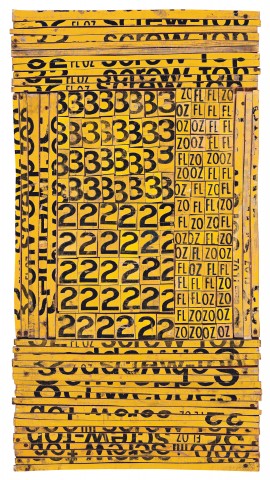LEDGER, 1992
ROSALIE GASCOIGNE
split soft drink crates on plywood
81.0 x 43.0 cm
signed, dated and inscribed with title verso: Rosalie Gascoigne / 1992 / LEDGER
Roslyn Oxley9 Gallery, Sydney
Private collection, Sydney
Phillips De Pury & Company, Sydney, 26 October 1998, lot 106
Lauraine Diggins Fine Art, Melbourne
Gould collection, Melbourne, acquired from the above in June 2000
Deutscher and Hackett, Sydney, 15 March 2017, lot 18
Private collection, Melbourne
Rosalie Gascoigne, Roslyn Oxley9 Gallery, Sydney, 15 April – 2 May 1992, cat. 30 (label attached verso)
Annual Collector’s Exhibition 2000, Lauraine Diggins Fine Art, Melbourne, 3 June – 24 June 2000, cat. 63 (illus. in exhibition catalogue)
MacDonald, V., Rosalie Gascoigne, Regaro, Sydney, 1998, fig. 25, pp. 34 (illus.), 35, 106, 111
Gellatly, K., Rosalie Gascoigne, Council of Trustees of the National Gallery of Victoria, Melbourne, 2008, fig. 10, p. 20 (illus.)
Gascoigne, M., Rosalie Gascoigne: A Catalogue Raisonné, ANU Press, Canberra, 2019, cat. 441, pp. 121, 137 (illus.), 256 (illus.)
Universally regarded as one of the most significant Australian artists of the twentieth century, remarkably Rosalie Gascoigne did not hold her first exhibition until the age of 57. Immediately attracting the praise of collectors and critics alike, she was soon offered a major survey exhibition at the National Gallery of Victoria, Melbourne (1978) and in 1982, was selected to represent Australia at the Venice Biennale (alongside Peter Booth), being the first Australian woman to receive this honour. In more recent years, she has featured in numerous important and international exhibitions, including the prestigious solo exhibition show Material as Landscape held at the Art Gallery of New South Wales, Sydney and National Gallery of Australia, Canberra (1997 – 98), and today is represented in all major collections in Australia and New Zealand, as well as the Museum of Modern Art, New York.
Of all Rosalie Gascoigne's achievements, undoubtedly the most striking and widely celebrated are her assemblages such as Ledger, 1992 which incorporate the shimmering black and gold text of weathered wooden Schweppes crates. Having eschewed the use of iconography, Gascoigne thus transforms text into texture – a wordplay of which she was no doubt aware – to create a powerful sense of landscape and light. With their rhythmic pattern composed of words and letters, such works have not surprisingly been described as 'stammering concrete poems’1, a perceptive analogy, especially given the artist's predilection for poetry from Shakespeare to Plath. Notwithstanding, Gascoigne stresses that the flickering word fragments, though carefully arranged, are not intended to be read literally: 'Placement of letters is important, but it's not a matter of reading the text – it's a matter of getting a visually pleasing result.’2
Similarly, her titles are not literal but rather, 'leave room for the viewer’3, imbued with various levels of meaning to be deciphered according to the nature of one's experiences. Accordingly, while the meticulous arrangement here of numbers and letters in columns and rows reminiscent of a ledger may perhaps be a tribute to the artist’s brother Douglas who was an accountant, ultimately the specific feeling evoked within the viewer depends largely upon his or her own memories. As John McDonald elucidates, Gascoigne's work '...awakens associations that lie buried beneath the surface of consciousness; inviting a higher degree of sensitivity and attentiveness to the world around us.’4 Indeed, it is this higher awareness, the ability to recognise beauty in the most humble of materials that Gascoigne demands of her audience. For, as the eye moves through this artful arrangement searching for information and the mind attempts to place different rules of perspective or build upon the suggestion of the marks, 'in time we realise that the only solution is to stop trying to navigate through the forest of symbols, and enjoy the beauty of the trees.’5
1. MacDonald, V., Rosalie Gascoigne, Regaro, Sydney, 1998, p. 35
2. Ibid.
3. Ibid.
4. McDonald, J., 'Introduction', in MacDonald, ibid., p. 7
5. Ibid.
VERONICA ANGELATOS
